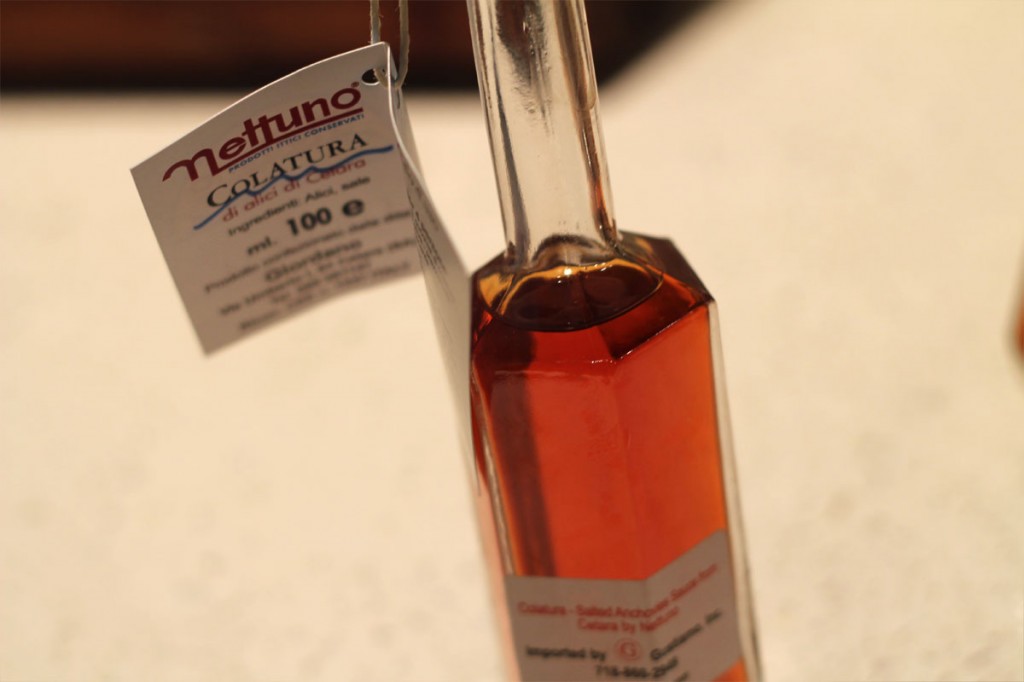by Allison Scola
Packaged in a delicate glass bottle with a long, thin neck and cork seal, a bottle of colatura resembles an alchemist’s ancient potion or my grandmother’s favorite perfume. It is an amber colored liquid with the consistency of soy sauce, and crudely explained to be “salted anchovy sauce” or “anchovy syrup.”
I heard whispers of colatura from various cooks, but because it can only be found in specialty Italian food stores, I hadn’t tasted it or cooked with it until this week. Food historians trace its origins to an ancient Greek and Roman condiment known as garum—giving colatura even more mystique. When my order arrived from Gustiamo.com, I sat with the bottle for some time. I turned it upside down to examine how the liquid flowed. I held it up to the light to see the spectrum of colors. I knew it was something special—something to be coveted—but I wasn’t sure what I would encounter.
Finally, I unsealed the packaging, a difficult task that reminded me of when I was a child attempting to open medicine from my parent’s cabinet. When I eventually cut through the seal and unplugged the cork, I was shocked by the pungent smell that rushed out of the bottle like the smoke of a trapped genie rushing from his lamp. On first impression, it could be described as the type of odor one encounters while walking past open fish markets on Grand Street in China Town.
Colatura has a sharp, brinish smell. The initial sensation is unambiguously fishy anchovies, but when used in small doses as it is meant to be, it transports you to the picturesque fishing village on the Tyrrhenian coast of southern Italy from where colatura comes. Its essence is smoky, oak-aged, and sea-salty with a hint of espresso.
I made a light pasta sauce with colatura by mixing it with fresh-squeezed lemon juice, lemon rind, minced garlic, red pepper flakes, extra virgin olive oil, and freshly chopped parsley: a cold sauce, perfect for a hot summer day. Southern Italians add it to vegetable dishes that feature escarole, potatoes, broccoli, and cauliflower.
The taste of colatura is derived from the careful, strategic process that is employed to create it. Plump, Mediterranean anchovies caught during the peak season of March through August are rinsed and cleaned of their insides and heads. Their bodies are then placed in rows inside an oak or chestnut barrel about the size of an antique water pail. Each layer of the silver bodies is sprinkled with sea salt and then layered with another series of anchovies. Once the barrel is two-thirds full of the anchovy-salt strata, the mixture is covered with a wooden disk and a heavy stone is placed on top of it in order to create pressure that prompts the barrel’s contents to ripen. After six months, during which a liquid that rises to the top of the barrel is periodically removed, the final stage of production is to pour the collected liquid back into the barrel. The purveyors then drill a small hole at the base of the barrel prompting the collected liquid to travel through the strata and finally, drip through the hole. Collected in glass containers, this liquid is then filtered through gossamer linen sheets and ultimately bottled for distribution.
Like a fine wine that has been aged and cared for in order to capture the essence of the earth, sky, and seasons where the varietal’s grapes grow, colatura captures the tastes and smells of Cetara, Salerno, the sunny, Mediterranean fishing village where it is created. It is an ancient potion with rewards for those who aren’t afraid to let the genie out of the bottle.
Allison Scola is Director of Communications at Columbia University School of General Studies and a professional musician with a great passion for Italian, Sicilian, and Italian American culture.


1 Comment
Pingback: Saint Joseph’s Day: Loaves for Thanksgiving, Charity, and Abundance | The Inquisitive Eater